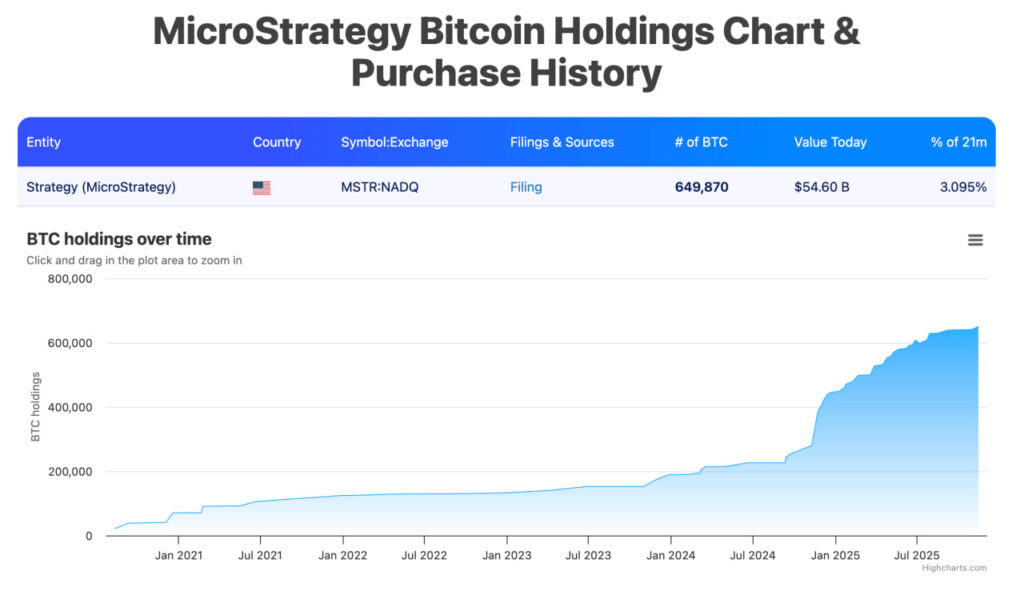MicroStrategy is still the biggest corporate holder of Bitcoin, sitting on roughly 649,870 BTC as of mid-November 2025. They bought all of this for around 48.37 billion dollars total, which puts their average cost at about 74,433 dollars per Bitcoin.

With Bitcoin dipping under 80k, things are starting to look uncomfortable for Michael Saylor and MicroStrategy. There is also a real risk that the company could be removed from the Nasdaq-100 Index, which is what QQQ and many tech-focused ETFs track.
Why? Because MSCI, one of the biggest index providers in the world, opened a consultation on whether companies whose digital assets (like Bitcoin) make up more than roughly half of their total assets should still be classified as normal operating companies. The final decision is expected around January 15, 2026.
If MSCI decides to exclude these “digital asset treasury companies,” MicroStrategy would be removed from MSCI indices. Analysts warn that this could trigger $ 2.8 to $ 11.6 billion in forced passive selling.
The probability of this happening is estimated to be between 80% and 95%. Some analysts believe the outcome is already priced in, which might explain part of Bitcoin’s recent sharp drop.
If MSCI removes MicroStrategy, passive outflows could reach approximately $ 2.8 billion. If Nasdaq-100, FTSE Russell, and others follow MSCI’s lead (which JPMorgan estimates at a 70 to 90 percent chance), total forced selling could reach $8 to $11 billion, roughly 15 to 20 percent of MicroStrategy’s market capitalization.
Despite all of this, Michael Saylor continues to buy and hold Bitcoin. He sees it as a long-term treasury strategy. However, in the short to medium term, this situation would pose a major headwind for the stock due to forced selling, reduced liquidity, and more challenging conditions for raising capital.
What Will Happen to MicroStrategy if Bitcoin Falls Under $74,000?
With everything happening right now, the only thing that could really help MicroStrategy is if Bitcoin holds up better than it currently is. However, it is not, and that is why the odds of BTC dropping below 74k are quite high.
If that happens, MicroStrategy’s Bitcoin holdings would start showing an unrealized loss on paper. Since MSTR trades like a highly leveraged Bitcoin proxy, the stock would likely take another major hit. It has already been sliding hard in recent weeks, and combined with the possible MSCI removal, the situation could get rough.
So is this the end of MicroStrategy and Michael Saylor? No, absolutely not. There will be no forced selling or margin calls in the near future. Most of MicroStrategy’s roughly 8 billion dollars in debt is in convertible notes that do not mature until 2027 through 2032.

MicroStrategy has already survived far worse twice before, especially in 2022 when people genuinely believed bankruptcy was on the table. Currently, the company’s Bitcoin stack remains deeply profitable, its debt structure is the cleanest it has ever been, and the only significant new threat is index exclusion.
They’ll say we got lucky.
— Michael Saylor (@saylor) November 20, 2025
That would hurt the stock because of forced passive selling. However, it does not threaten the company itself, nor does it force them to sell their Bitcoin. Though it’s likely Saylor is not going anywhere. Long live Bitcoin.
DISCOVER: Best Meme Coin ICOs to Invest in 2025
Join The 99Bitcoins News Discord Here For The Latest Market Updates
Key Takeaways
- MicroStrategy faces real pressure from the MSCI index review and a potential drop under 74k. But none of it forces them to sell Bitcoin or threatens the company’s survival.
- MSTR may see heavy forced selling and stock volatility. Yet its debt is long-term, its BTC stack is still profitable, and Saylor remains fully committed to holding.
The post What Will Happen To Microstrategy If Bitcoin Falls Under $74,000? appeared first on 99Bitcoins.








